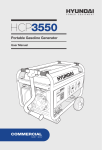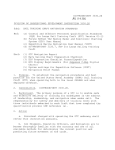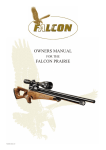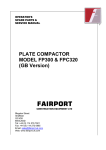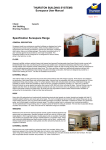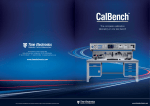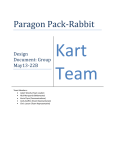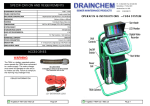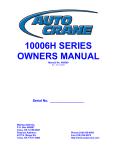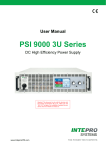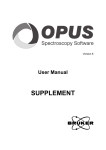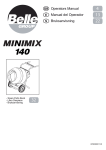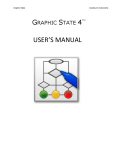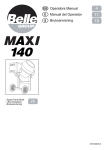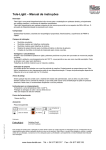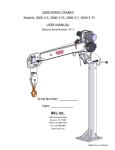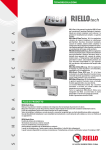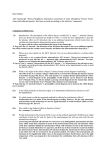Download table of contents
Transcript
TABLE OF CONTENTS Section Subject Page 1 WARRANTY 3 2 2.1 2.2 2.3 WARNING & SAFETY INSTRUCTIONS Warning Safety instructions Instruction & Safety Labels on Machine 3 3 3 4 3 3.1 3.2 3.3 3.4 3.5 GENERAL Using the operation & maintenance manual Telelight description Marking EC Declaration of Conformity Technical information 6 6 6 7 7 9 4 4.1 4.2 4.3 4.4 4.5 4.6 4.7 4.8 4.9 4.10 4.11 OPERATION Inspection & preliminary operation Manoeuvring Maximum wind speeds Earth requirements Miniature circuit breakers Starting the engine Unit positioning and mast deployment Operating the lights Outlet power sockets Lowering of mast Preparing for removal from site 10 10 11 11 11 11 11 12 13 13 13 13 5. 5.1 5.2 5.3 5.4 TRANSPORT and STORAGE Prior to transporting Lifting the Telelight Transporting by lorry Storage 14 14 14 15 15 6 6.1 6.2 6.3 6.4 MAINTENANCE Service Safety information Maintenance Diesel generator maintenance 15 15 17 17 18 2 1. WARRANTY Warranty pertaining to your Telelight is explained in the Company’s separate booklet entitled Registration & Warranty Information (RW1). This booklet should be read in conjunction with these operator’s guidance notes. 2. WARNING & SAFETY INSTRUCTION Failure to follow the warning instructions could result in severe injury or death to the operator, a bystander or a person inspecting or repairing the machine. 2.1 WARNING Operators should be trained in the safe use of the Telelight. If training has not been carried out this should be reported to to your designated Company safety officer. Do not operate the Telelight unless trained in its safe use. Voltage used in this equipment can endanger life. Before attempting replacement of components or maintenance operations, ensure that any power supply and the generator are switched off. The engine and generator set comprises components and fluids that, in operation, are subject to high temperature. Caution is required to avoid burns and scalding. The Telelight is equipped with moving parts, pulleys & belts. Be careful in the vicinity of the machine and avoid wearing loose clothing. In case of fire do not use water. Use only an appropriate fire extinguisher. Do not operate the Telelight in poorly ventilated areas, as exhaust gasses can be extremely dangerous/fatal. 2.2 SAFETY INSTRUCTIONS For safety operation observe the following instructions: Exhaust gases The exhaust gases contain harmful carbon monoxide. Operate the Telelight in a spacious, well ventilated, area. Electric shock prevention Never touch the Telelight with wet hands. IMPORTANT: Ensure the Telelight is EARTHED correctly. 3 Fire prevention Avoid placing any flammable materials near the exhaust outlet during operation. When filling the fuel tank be sure to stop the engine and take care not to spill fuel. Do not refuel near fire, flame or sparks. Do not smoke whilst refuelling. Wipe off any spilt fuel immediately before re-use. Other precautions Never allow untrained persons to operate the Telelight. Never move the Telelight during operation. Operate the Telelight on a level base. During use, keep the Telelight at distance from buildings and be sure that the exhaust gases are not conveyed into buildings or closed environments. Do not use the unit for lifting purposes for anything other than that for which it is designed. 2.3 INSTRUCTION & SAFTEY LABELS ON MACHINE The drawings are provided by way of example. The operating instruction, warning & safety labels form an integral part of the Telelight. The unit you have in your possession may differ in minor areas, the safety of the unit and the information provided are nevertheless guaranteed. DIAGRAMS/ LABEL EXPLANATIONS Figure 1 Front Elevation 4 Figure 2 Side Elevation Figure 3 Rear Elevation + Radiator 5 Figure 4 Upper Elevation DIAGRAMS/ LABEL EXPLANATIONS IMPORTANT FULLY BUNDED UNIT INSPECT REGULARLY, DRAIN AS REQUIRED ENSURE ALL PLUGS ARE RE-FITTED. KEEP DOORS CLOSED WHENEVER PRACTICAL. BATTERY ACCESS LA15459 LA03022 Diesel Fuel RADIATOR FILL ALLOW TO COOL DEPRESSURISE CAREFULLY LA01945C FLAMMABLE LA15447 6 WARNING Do not operate lamps with glass removed or broken. Fully slacken BOTH clamps prior to adjusting the lamp angle LA15602 LA15462 Lamp Deployment Transport Mode L Deployed Mode 1 WA 85 dB Deployed Mode 2 LA15587 LA15649 LA15461 LOCK MAST ROTATOR 7 RELEASE LA15647 FORKLIFT POSITIONS LA15584 LA15653 LA15653 ENGINE OIL DRAIN LA15604 LA15654 LA15518 8 LA15654 3. GENERAL 3.1 USING THE OPERATION & MAINTENANCE MANUAL The scope of this document is to support the operator in safely deploying and maintaining the Telelight. This manual is organised in sections with the following information: Section 1 Warranty Information. Section 2 Section 2 contains the most important warning and safety instructions. More specific safety information is contained in the specific sections for maintenance and operation. Section 3 Section 3 gives general information about the Telelight. This section also includes help in handbook interpretation includes the technical data of the Telelight and it’s main sub-assembly components. The information included in this section may be duplicated or integrated in the diesel engine manuals, the AC alternator manual and the control panel wiring diagrams. Section 4 Section 4 refers to inspection and preliminary operation. It includes useful information on deployment, outlet sockets, earthing, manoeuvring and preparing for removal of Telelight from site. Section 5 Section 5 provides information on transport, storage, lifting and handling the Telelight. Section 6 Section 6 provides information and procedures for routine, corrective maintenance and advice on safety. The section also includes a timetable for periodic maintenance. This section has to be read in conjunction with the engine and alternator maintenance books that are supplied with the Telelight. 3.2 TELELIGHT DESCRIPTION The Telelight consists of a diesel engine coupled to an AC alternator mounted within a fully sound suppressed canopy. The rotating mast has 9 sections which extend by hydraulic cylinder and via wire ropes to a height of 9.0 metres. The mast is fitted with four Metal Halide Lamps. 9 An optional Power Tilt mechanism for remote adjustment of lamps is available. Two external power sockets are provided. Four stabiliser legs are fitted for safe operation when mast is deployed. The entire unit is fully mounted onto a fast tow trailer with overrun and park brake facility. Road lighting is fitted as standard. The Serial Number of the Telelight should be quoted in any communication. 3.3 MARKING The Telelight identification plate contains all the identification data required to conform to the provisions for CE Marking. The plate is fitted on the front right hand side of each Telelight, an example is shown in Fig. A. SANDHURST MANUFACTURING CO. SGN KG 1- MACHINE TYPE SERIAL No. ENGINE POWER YEAR OF MANUFACTURE KG Sandhurst Mfg Co Gosberton, Spalding, Lincolnshire. PE11 4HG Tel: 44 (0) 1775 840020 Fax: 44 (0) 1775 843063 100 KG Figure A 3.4 7.7 kW @ 1500rpm LA10454 SERIAL NO. PLATE DECLARATION OF CONFORMITY The Telelights supplied by Sandhurst Manufacturing Company Ltd are in conformity with all the applicable EEC Directives and are furnished with an EC Declaration of Conformity, an example is shown in Fig. B. 10 EC CONFORMITY CERTIFICATE 2. EC CONFORMITY CERTIFICATE No. 1. MANUFACTURER 1 Sandhurst Manufacturing Co 2 SMC/EC/2222 Roman Bank, Cherry Holt Road Bourne, Lincolnshire PE10 9LQ United Kingdom 3. CERTIFICATE HOLDER 4. ISSUING DIRECTIVE APPLICABLE 98/37/EC as amended by 98/79/EC 2000/14/EC 89/336/EEC 89/336/EC 73/23/EEC as amended by 93/68/EEC 3 As above 5. NOISE TECHNICAL CONSTRUCTION FILE No. SMC/2002/0029 Date 6. Conformity assessment procedure to EC directive 2000/14/EC annexes V1 (UK regulation SI 2001/1701) unit verification. 25/10/05 Measured sound power level db 84 Guaranteed sound power level db 85 (LWA) Notified body: AV Technology Ltd. AVTech House Birdhall Lane, Cheadle Heath, Stockport, Cheshire SK3 0XU 7. DESCRIPTION OF EQUIPMENT Make: SMC Category: Mobile Lighting Tower/Generator Model: TL90 Type of drive: Diesel (Kubota D905) Serial No.(s) Manufacturer: Sandhurst Power/Revs. 7.7 kW/1500 rpm 8. Complies with transposed harmonised standards, national standards and technical specifications applicable to it. In particular one or more of the following; ISO 1103,3853,4223/1,7641/1,IEC227, IEC972, EN40 BSI 7211,6651,7530,5000,AU114b, AU113c, AU50 EN 292,349 & 4745. ISO 3744, 6395 9. Signature of responsible person ____________________ Name of responsible person Position of responsible person Issued on behalf of: Robin Brand Technical Director Date ____________________ Figure B 11 Bourne, Lincolnshire PE10 9LQ United Kingdom 3.5 TL90 TECHNICAL SPECIFICATION ENGINE Model Type Cylinders Bore mm Stroke mm Displacement cu.cm. Power. kWm RPM Oil Sump Capacity. Litres Engine Stop System Fuel Pump Fuel Tank Capacity. Litres Fuel Consumption. l/hr. Max. Hours Run. 4 Lamps Only Starting Battery. Ah-V Alternator Amps-V Kubota D905-BG Diesel Water Cooled 3 72 73.6 898 7.7 1500 5.1 12v Solenoid. Energised To Run 12v Electric 130 2.25 (at Continuous rating) 80 70 12 30 12 ALTERNATOR Type Voltage Frequency. Hz Continuous Power. kW Standby Power. kW. Voltage Stability Std. Outlet Sockets Mecc Alte C2 130/4P 230v 50 5 5.6 6% 2 x 16 Amp 230v Mast: Max. Height Mast: No. of Sections Mast Raise Time secs. Mast Lower Time secs. Lamp Specification Total Light Output Initial lumens Total Light Output Mean lumens Mast Actuation Lamp power tilt (optional). Tyres Tyre Pressure bar/psi Dimensions Transport Mode Dimensions Fully Deployed Weight. Kg. Fully Fuelled Weight. Kg. No fuel 9 9 12 18 4x 1000w 230v Metal Halide 106,000 per lamp head 85000 per lamp head Hydraulic-185bar 12v Power Pack 12v 175R13 2.4/35 2500L x 1320W x 2100H 2500L x 2630W x 9000H 1050 933 Noise Level @ 7 Metres Sound Power Level LwA Vibration m/sec sq. Enclosure Protection 60dB(A) Approx. 85dB(A) Less than 2.5 IP 23 12 Max. Wind Speed kph (mph) Bund 120% of fluid content 100 (60) Engine Liquids & Fuel Tank 4. 0PERATION 4.1 INSPECTION & PRELIMINARY OPERATION 4.1.1 Prior to each operation of the Telelight, including raising or lowering the mast, a thorough inspection should be made. Included in this inspection must be: a) Wire ropes and pulleys. Check rope for fraying, kinks and stretching. Replace if not good working order. b) Power cable and fittings. Check for chaffing and cuts and other visible defects. Replace if not in good working order. c) Mast hydraulic cylinder. Inspect mountings and check for hydraulic leaks. d) Mast wear pads. Inspect for damage or wear, replace as necessary. e) Rotation mechanism function correctly. Check rollers & bushes for damage or wear, replace as necessary. f) Lamp fittings are in good working order. Important! Do not operate lamps with glass damaged or missing, replace damaged glass immediately. Failure to do so can damage health. Faulty lamps must be replaced immediately. Failure of lamp can also result in damaged to the control gear if unit remains switched on. c) Outriggers, prop stands & jockey wheel. d) Check mast deployment warning device is fully functional. e) Check park brake is operational. f) Ensure all operation and warning labels are legible. 4.1.2 Check fuel, engine oil, and coolant if appropriate, as per the instructions in the engine manufacturer’s handbooks. 4.1.3 Check bund daily for fluids, drain into suitable container if necessary. 4.1.4 Each week and before each new operation of the mast; hydraulic cylinder, wire ropes, electric cable and sockets, lifting points, brakes and all other safety aspects should be checked by an authorised engineer. Check battery electrolyte. 4.1.5 Notwithstanding obligations as described in 4.1.1, at 12 monthly ntervals an examination should be made of the Telelight structure, mast, mast hydraulic cylinder, and lifting points (if applicable). Wire ropes should be thoroughly examined at 6 monthly intervals. New wire ropes should be fitted every 12 months. A competent authority should issue new certificates after satisfactory testing. Note! The latter two items apply particularly to the UK. Units used outside the UK should be homologated to conform to local regulations, the onus being on the user to research these and comply. In the absence of local regulations follow as a minimum the rules as above for the UK, and consult your distributor. 13 4.2 MANOEUVRING 4.2.1 Use sufficient persons and equipment to control the lighting tower when manoeuvring. Never manoeuvre with the mast raised. Prior to raising mast check for overhead obstructions and in particularly overhead electric power lines. Please consult HSE Guidance Note GS 6, Avoidance of danger from overhead electric power lines. This provides guidance to the user on safe working practice when working on sites where overhead electric power lines may be present. The information within this publication should be adhered to at all times. Please note that the Telelight is fitted with an audible warning system which will automatically be activated when the mast is being raised or lowered. The warning system also interacts with the park brake, should the park brake be released, to inadvertently move the Telelight whilst the mast is deployed, the audible alarm will sound and the mast will automatically lower. Beware of mast movement. 4.3 MAXIMUM WIND SPEEDS Never raise the mast or allow it to remain elevated in wind speeds in excess of 100 kph (60mph). 4.4 EARTH REQUIREMENTS The Telelight should be earthed. Use a ground earthing spike driven into the ground to a minimum depth of 0.5 meter and connect with a suitable cable to the trailer earth connector. An earth spike of minimum 10 mm diameter and a 10 sq.mm copper cable is supplied with the unit. Ensure a good earth is achieved either by utilising this earthing rod or other suitable means. 4.5 MINATURE CIRCUIT BREAKERS (MCB’s) These are incorporated in the control panel to protect both lamp and external socket outlets, they are switched manually. 4.6 STARTING THE ENGINE 4.6.1 Ensure MCB’s are switched off when starting and stopping the engine, failure to do so could damage the alternator. 4.6.2 If, having started the engine, you intend to use the power supplied by the alternator you should earth the lighting tower unit as at 4.4 above. 4.6.3 Check fuel, oil and coolant, if appropriate, as per the instructions in the engine manufacturer’s handbook. 4.6.4 Follow the starting procedure on the ‘Operator’s Instruction Label 14 fitted to the Telelight. 4.6.5 Stop the engine according to the procedures given in the ‘Operator’s Instructions’ label. Consult engine manufacturer’s handbook, if required. Note: RCD’s are fitted; test their function by using the ‘test’ button when the generator is running. IMPORTANT! If the RCD’s/RCBO’s do not function correctly, do not operate the equipment, seek advise from a competent party. Note: For terminology refer to descriptions in the parts manual. 4.7 UNIT POSITIONING AND MAST DEPLOYMENT 4.7.1 Check your obligations under 4.1 and 4.2 above and comply. 4.7.2 Level the unit by adjusting the jockey wheel and ensure the ground upon which it is installed is stable. 4.7.3 Apply the trailer handbrake. 4.7.4 Lower the rear jacklegs first and lock in position, extend the front outriggers, lower front jacklegs and lock in position. 4.7.4 Check that the jacklegs are on good, stable ground. 4.7.5 Carry out inspection as described in 4.1.1 above. 4.7.6 Carry out check described in 4.1.2 above. 4.7.7 Check the area surrounding the unit is clear of persons and property. 4.7.8 Check overhead, care must be taken to avoid raising the mast in the proximity of overhead power lines, cables and any obstructions. 4.7.9 Check the emergency stop push button is in the open position (out),if it is closed turn to release. 4.7.10 Check MCB’s are ‘off’ 4.7.11 Connect plugs to outlet sockets on control panel, if applicable. 4.7.12 Adjust lamp units for illumination; slacken retaining fasteners fully prior to adjusting. Ensure all fasteners are fully tightened after adjustment. When positioning and illuminating lamps due consideration should be given to the safety and health implications due to glare for other parties in the vicinity including motorists. 4.7.13 Raise the mast to the required height with the obvious maximum being the full extension of all sections, this is controlled by the maximum stroke of the mast cylinder. The hydraulic relief valve in the power pack will protect against undo hydraulic overload. Observe during extension that all mast parts are functioning correctly including the coiled cable. 4.7.14 If illumination is not required, switch off the engine as per procedure described in 4.6.5 above. 4.8 OPERATING THE LIGHTS 4.8.1 Ensure procedures described in 4.4 have been carried out. 4.8.2 Check, wherever practical, that electrical connections are in good condition. 4.8.3 Carry out procedures described in 4.6.1 4.8.4 Switch on lamp MCB’s, one at a time. 4.9 OUTLET POWER SOCKETS. 4.9.1 Do not connect or disconnect plugs/sockets without first switching off the MCB’s. 15 4.9.2 Consult the alternator manufacturer’s handbook to understand the capability of your alternator. If your proposed use will overload the alternator adjust your requirement to suit. If you are unsure seek advice from the Company or your distributor and do not proceed to connect to the unit until you have been correctly advised. Ensure that when connecting equipment to the outlet sockets that you may do so safely and without detriment to the equipment, persons or property. 4.9.3 Subject to your obligations under 4.9.2 above: a) Switch off MCB’s one at a time b) Connect and disconnect plugs/sockets as applicable c) Check that all connections are properly and firmly made and that all electrical fittings and wiring are in good condition. d) Switch on the MCB’s one at a time. . 4.10 LOWERING OF THE MAST. 4.10.1 Check that the Telelight park brake is ON. 4.10.2 Switch off MCB’s and ensure the engine is not running.. 4.10.3 Ensure that the area around the unit is clear of persons and property. 4.10.4 Manually rotate the mast until the transport lock engages, see instruction label on the Telelight. 4.10.5 Operate the hydraulic mast cylinder to lower the mast. Beware of lamps when lowering. 4.10.6 Observe that all mast parts are functioning correctly and that the coiled cable retracts into it’s transport stowage tube. 4.10.7 Adjust lamps into their transport position and ensure all fastenings 4.10.8 Failure of the mast to fully lower. In the unlikely event of the mast sections not fully retracting during lowering: 4.10.9 Check the mast wires, if any are slack, raise the mast until the wires are taut. 4.10.10 Ensure that all personnel, including the operator are clear of the Telelight and remain clear of the working area around the unit. 4.10.11 Consult authorised personnel for advice if required.. NEVER USE UNSAFE EQUIPMENT 4.11 PREPARING FOR REMOVAL FROM SITE. 4.11.1 Following lowering of the mast as described in 4.10 above, recover the ground earthing spike and cable. Pack for transportation. 4.11.2 Raise jacklegs and ensure they are well secured in their clamps. Retract outriggers and ensure they are well secured. 4.11.3 Adjust lamp fittings to transport position, see instruction labels on unit, lock off all retaining fasteners. Caution: lamp fittings may be HOT. 4.11.4 Connect the Telelight to the towing vehicle as required. Raise the jockey wheel and ensure that it is secure 16 5. TRANSPORT AND STORAGE Failure to follow instructions in this section could result in severe injury or death to the machine operator, bystander or others! 5.1 BEFORE TRANSPORT. Prior to transportation ensure that the following: 5.1.1 5.1.2 5.1.3 5.1.4 5.1.5 5.1.6 Ensure preparation as listed in 4.11 has been carried out. Check battery is secure. Make sure that all loose components are correctly stowed. Verify that the fuel and oil tank caps are securely tightened. Verify that all doors and covers are secure. If intending to road tow on public highways, ensure tow vehicle is suitable for purpose, check a suitable tow coupling is fitted and that the Telelight is coupled correctly to the tow vehicle. Check breakaway cable is connected to tow vehicle. Affix towing vehicle’s registration plate to the Telelight retaining clips at rear of unit. Plug lights and indicators into the towing vehicle’s supply source. 5.1.7 Check the Telelight unit and towing vehicle to be suitable for travel. Check that road lights and indicators are working correctly. Check lighting tower unit tyres to ensure that they are not perished or damaged and that they are correctly inflated. See 3.5,technical information, for recommended tyre pressure. 5.1.8 Release park brake and check overrun brakes are operating satisfactorily. 5.1.9 Check content of bund, drain if necessary into suitable container. 5.1.10 Tow away when satisfied that it is safe and legal to do so. 5.2 LIFTING THE TELELIGHT 5.2.1 Employ suitable slings and equipment. Follow best practices and obey local regulations. 5.2.2 Ensure mast, lamps, stabiliser legs and control panel covers are all locked in their transport mode as 4.11. 5.2.3 Rear access lifting pockets for forklift tines and a top mounted central lifting eye are provided on the Telelight for safe lifting of the unit. (Subject to local regulations). 5.2.4 Inspect fork tine lifting pockets & central lifting eye prior to anyy lifting operation. Important! The lifting pockets for forklift tines and central lifting eye are designed for lifting the unit onto transport vehicles within close proximity. They are not designed for transporting units over distances particularly over rough terrain. 5.2.5 Care should be taken to avoid damage to lamps, etc. during lifting operations. 5.2.6 Do not attempt to lift Telelight with mast raised. Follow local regulations-Be safe. 17 Note : The Company issues a type-test certificate valid in the UK only. 5.3 TRANSPORT BY LORRY For transporting by lorry ensure that the lorry payload is sufficient for the Telelight(s). After loading firmly secure the Telelight(s) to the lorry. Note: Retaining lugs are incorporated on the underside of the Telelight chassis for retaining straps. 5.4 STORAGE The storage operation is very important in order to preserve the efficiency of the Telelight. There are some operations suggested only for long-term storage (over 3 months) and others for medium term storage (up to 3 months). Others are to be carried out each time that the Telelight is out of regular use. OPERATION DESCRIPTION Disconnect the cables and store all loose components SHORT TERM MEDIUM TERM LONG TERM X X X X X Disconnect the batteries Remove the batteries and keep them in a fresh dry room recharging them every 3 months Remove the fuel from the tank X Remove the engine lube oil X Wipe off any spilt liquids X X Wash the canopy externally with water and spray surfaces with protective oil and lubricate the hinges and door locks Drape the Telelight with plastic to protect against dust and humidity X X X X X X Clean the control panel and spray the cabling and connectors with protective oil. X Lubricate all wire ropes. X X More information regarding storage is available in the engine handbook. The storage environment is to be free from humidity and dust Be sure that there is no danger of flame or heat in the storage environment. 6. 6.1 MAINTENANCE SERVICING 18 Service the engine, alternator and running gear as per the instructions given in the appropriate manufacturer’s handbook. Note: Operators and owners are responsible for undertaking all services including the first service. Note: for terminology refer to descriptions in parts manual. NOTE! In case of emergency it is always possible to shut down the Telelight by pushing the Emergency Stop push button located on the control panel. 6.2 SAFETY INFORMATION In addition to the general safety information mentioned in section 2, it is important to pay attention during maintenance operation to the instructions listed below: Failure to follow the WARNING instructions could result in severe injury or death to the machine operator, a bystander or others. Voltage used in this equipment can endanger life. Before attempting replacement of components or maintenance operation ensure that all power supplies and equipment are switched off. The Telelight includes components and fluids that, during operation, are subject to high temperature. Be careful to avoid burns and scalding. Use protective gloves and safety glasses during refuelling and engine oil changes. Before draining allow the oil to cool below 50qC. The Telelight is equipped with moving parts, pulleys, wires and belts. Be careful in the vicinity of the machine and be sure to dress in appropriate work clothes. Do not wear loose clothing, rings or necklaces when working near the machine or moving parts. Pressurised air used for cleaning must be lower than 2 bars. Wear a protective helmet when appropriate and wear protective shoes and overalls. Immediately change wet overalls. Do not light fires during refuelling. In case of fire do not use water use only an appropriate fire extinguisher. When working on parts under voltage ensure that hands and feet are dry. Do not execute unfamiliar repairs, follow instructions and if not available contact the manufacturer/dealer. Keep the engine clean. Remove all fuel, oil or other liquids from its surfaces. Provide an adequate container for waste oil. 19 6.3 ROUTINE MAINTENANCE This section provides general instructions for the Telelight maintenance and a summary of the principal maintenance operations of the parts. Complete maintenance instructions for the main parts (engine & alternator) are detailed in the relevant specific manuals supplied with the Telelight. OPERATION Check engine oil level Clean air filter Check battery condition and connections Clean cooling system Replace engine lube oil * Replace oil filter * Replace fuel filter Replace air filter Check engine fan belt tension & condition Replace engine fan belt Replace AVM’s Check fuel pipes and rubber parts Change fuel pipes Replace engine injector nozzles Clean fuel pump Clean fuel tank Check valve clearance Clean control panel Check hydraulic power pack oil level Check bund, drain as necessary DAILY 125Hr 150Hr 250Hr 500Hr 1000Hr 2000Hr X X X X X X X X X X X X X X X X X X X X X * Note! The first engine oil change and filter must be carried out after 50hrs of operation. Note! Operators and owners are responsible for undertaking all services including the first service. Note! Hydraulic power pack oil specification is Qualube Enviroyl Hydrasyn HT.46 Biodegradable. DIN 51524 Part 2.(modified for biodegradable fluid). Please ensure when topping up and/or replacing hydraulic oil that specification is compatible with the above. 20 6.4 DIESEL GENERATOR MAINTENANCE OPERATION The engine oil level should be checked daily. The level must be between the marks ‘Min’ and ‘Max’ marked on the dipstick. Refill if necessary without exceeding the ‘Max’ position. The oil must be replaced in accordance with the engine manufacturers recommendation. Drain the oil by opening the drain valve on the engine sump. The fuel filter must be replaced every 500 hours. When replacing the fuel filter, fill the new filter with diesel fuel before installation to help extract air from the fuel system. The oil filter must be replaced every 500 hours. The air filter should be cleaned daily and replaced every 500 hours. This should be reduced if the engine works in a dusty environment or in conditions of high humidity. The engine fan belt must be checked every 500 hours and replaced every 1000 hours. The anti-vibration mounts must be replaced after 2000 hours. Replace all units together as a complete set. Fuel pipes and other rubber parts should be checked every 500 hours. Fuel pipes should be replaced after 1000 hours. The fuel pump, injector nozzles and valve clearance should be checked every 2000 hours. Trained personnel must perform this operation. The battery and connectors must be checked every 125 hours. The fuel tank must be cleaned every 1000 hours. It is important to drain water and sediments from the tank. Use the tank drain valve for this purpose. . 21





















